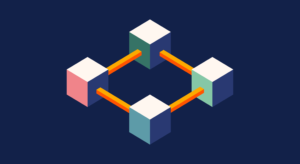
Blockchain technology has revolutionized the way we think about digital transactions and data storage, but it has also faced significant challenges in terms of efficiency and scalability. As the adoption of blockchain continues to grow, the need for solutions that can handle increased transaction volumes and diverse use cases becomes more pressing. These two key approaches are emerging as potential solutions to enhance scalability, efficiency, and usability: multi-layer architecture and interoperability. Each offers unique advantages and challenges that could shape the future of blockchain applications.
Multi-Layer Architecture in Blockchain
Multi-layer architecture is an innovative approach in blockchain design that aims to enhance scalability, efficiency, and usability. By separating the protocol into distinct layers, this architecture allows for more flexible solutions to some of the most pressing challenges faced by blockchain networks today.
Understanding Multi-Layer Architecture
- Layer 1 (Base Layer): This is the foundational layer, comprising the main blockchain protocol (e.g., Bitcoin, Ethereum). It is responsible for maintaining the network’s security, consensus, and data integrity.
- Layer 2 (Scaling Layer): This layer operates on top of the base layer and focuses on enhancing scalability and transaction speed. Examples include:
-
- State Channels: Allow off-chain transactions between participants, settling on the main chain only when necessary.
- Sidechains: Independent blockchains that run in parallel to the main chain, allowing for specialized functionalities without congesting the main network.
- Rollups: Solutions like zk-Rollups and Optimistic Rollups bundle multiple transactions into a single one, reducing the load on the base layer.
- Layer 3 (Application Layer): This layer encompasses decentralized applications (dApps) that utilize the underlying blockchain infrastructure. It focuses on user interaction, providing interfaces and functionalities tailored to end-users.
Benefits of a Multi-layer Architecture:
the chief benefit of three-tier architecture is its logical and physical separation of functionality. Each tier can run on a separate operating system and server platform – for example, web server, application server, database server – that best fits its functional requirements. And each tier runs on at least one dedicated server hardware or virtual server, so the services of each tier can be customized and optimized without impacting the other tiers.
Other benefits (compared to single- or two-tier architecture) include:
- Faster development: Because each tier can be developed simultaneously by different teams, an organization can bring the application to market faster. And programmers can use the latest and best languages and tools for each tier.
- Improved scalability: Any tier can be scaled independently of the others as needed.
- Improved reliability: An outage in one tier is less likely to impact the availability or performance of the other tiers.
- Improved security: Because the presentation tier and data tier can’t communicate directly, a well-designed application tier can function as an internal firewall, preventing SQL injections and other malicious exploits.
Interoperability in Blockchain
- Interoperability focuses on creating connections between different blockchain networks.
- It allows for seamless transfer of assets and information across disparate systems.
- Enables users to leverage unique features of different blockchains without being confined to a single network.
The importance of interoperability becomes evident when considering the diverse landscape of blockchain applications. Some networks may excel in smart contract functionality, while others might offer superior privacy features or faster transaction speeds. By enabling these networks to communicate and share resources, interoperability allows for the creation of more complex and powerful decentralized applications that can draw upon the strengths of multiple blockchains.
Furthermore, interoperability promotes liquidity and efficiency in the broader cryptocurrency market. It allows for easier asset transfers between different chains, reducing the friction and costs associated with moving value across blockchain ecosystems. This fluidity not only benefits users but also enhances the overall stability and functionality of the decentralized finance (DeFi) sector.
Combined Benefits of Layers and Interoperability
- Layered solutions provide vertical scalability within a blockchain ecosystem.
- Interoperability offers horizontal scalability across different blockchain networks.
- Together, they create a multidimensional approach to addressing blockchain limitations.
When we consider the advantages of numerous layers and interoperability, we may see the creation of a more sophisticated and powerful blockchain architecture. A decentralized application that leverages the high security of one blockchain’s foundation layer, the rapid transaction speeds of another’s Layer 2 solution, and the privacy characteristics of a third network.
In a fully interoperable, multi-layered blockchain environment, this is not only possible, but also seamless. Such an application might take advantage of each network’s strengths while maintaining performance and functionality.
This layer-level synergy and interoperability also pave the way for more novel consensus methods and governance structures. As multiple layers and chains interact, they can share not only data and assets, but also innovative approaches to addressing common blockchain obstacles.
This cross-pollination of ideas and technology has the potential to expedite the evolution of the whole blockchain field, resulting in more robust and efficient systems overall.
Enhanced User Experience and Developer Flexibility
- End-users benefit from faster, cheaper, and more versatile blockchain services.
- Developers can design systems that automatically select the most appropriate blockchain or layer for each specific function.
- Allows for the creation of more sophisticated and efficient dApps that can adapt to changing network conditions and user needs.
Moreover, the combination of layered solutions and interoperability can significantly enhance user experience. End-users may not need to understand the complex architecture behind their transactions; they simply benefit from improved blockchain services. This abstraction of complexity is crucial for mainstream adoption, as it allows blockchain technology to become more accessible to non-technical users.
Fostering Collaboration in the Blockchain Ecosystem
- Reduction in tribalism as projects focus on core competencies while maintaining interoperability.
- The emergence of a more cooperative environment where blockchain projects complement rather than compete.
- Potential for accelerated innovation through shared knowledge and resources.
The impact of combining multiple layers and interoperability extends beyond technical improvements. It also has the potential to foster a more collaborative and inclusive blockchain ecosystem.
The future of blockchain reinforcement is not a one-size-fits-all solution. Both multi-layer architectures and interoperability play crucial roles in advancing the technology. While multi-layer solutions offer immediate scalability improvements, interoperability paves the way for a more integrated and collaborative blockchain ecosystem.
As the industry continues to evolve, the most successful projects may well be those that can effectively combine both approaches, leveraging the strengths of multi-layer systems while fostering seamless interactions across diverse blockchain networks. The future of blockchain is bright, with endless possibilities on the horizon.




